This collection highlight blog post was written by Jimmy Chang, an archival processing assistant on the Archival Backlog Elimination Project. Jimmy Chang received his bachelor's and master's degrees in architecture from the University of Nevada, Las Vegas School of Architecture with a tract in hospitality design. His thesis focused on the rediscovery, promotion, creation, and development of history through the connections between architecture and fiction, and he has worked with roofing and architectural companies before working as an archival assistant at UNLV Libraries Special Collections and Archives. He is currently working toward entering the fields of architectural history and conservation.
This post celebrates the Hughes H-4 Hercules "Spruce Goose" Seaplane which took its one and only flight November 2, 1947 and the Edward C. Light Schematic Drawings of the Hughes H-4 Hercules "Spruce Goose" Seaplane, 1941-1950, held by UNLV Special Collections and Archives.
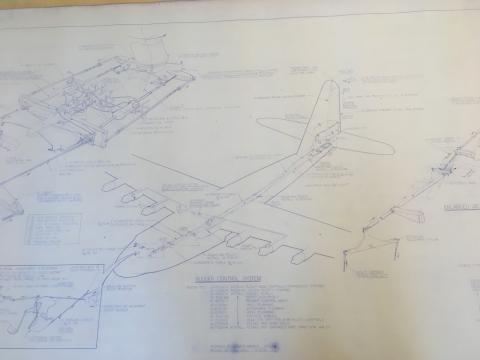
Image Source: Perspective of the rudder controls installation, Edward C. Light Schematic Drawings of the Hughes H-4 Hercules "Spruce Goose" Seaplane, 1941-1950. MS-00920. Special Collections and Archives, University Libraries, University of Nevada, Las Vegas. Las Vegas, Nevada.
Edward C. Light, an aeronautical engineer at the Hughes Aircraft Company, supervised the design of the Spruce Goose’s aircraft control system between 1941 and 1950. Light also contributed his expertise in aircraft instruments, stability and control of systems, instrument landing systems, autopilot design, radio and inertial navigation, electro-optical sensing systems, and guidance and control of missiles. His drawings for the Hughes H-4 Hercules “Spruce Goose” seaplane detail innovations in engineering, allowing for the flight of the largest primarily wooden aircraft ever built.
The Great Aviator: Howard Hughes, His Life, Loves & Films — A Documentary (2004), directed by Lynn Stevenson, includes footage of Hughes testimony before the Senate War Investigating Committee in 1947 for the use of government funds for the Spruce Goose. During one of these hearings, Hughes stated:
“… the Hercules was a monumental undertaking. It is the largest aircraft ever built. It is over five stories tall with a wingspan longer than a football field. That’s more than a city block. Now, I put the sweat of my life into this thing. I have my reputation all rolled up in it and I have stated several times that if it’s a failure, I’ll probably leave this country and never come back. And I mean it.”
The Spruce Goose’s existence can be likened to a film fantasy at the time of its design and first flight. It could fit 165,000 cubic feet of cargo, and had a payload of 130,000 pounds. Also, at 320 feet, its wingspan measures the length of approximately 23 typical sedans—the world’s longest wingspan of any flight-capable aircraft until the flight of the Scaled Composites Stratolaunch on April 13, 2019. But, if that wasn’t impressive enough, at upwards of 20 feet long, the Spruce Goose’s drawings span the length of almost one and a half of those same sedans!
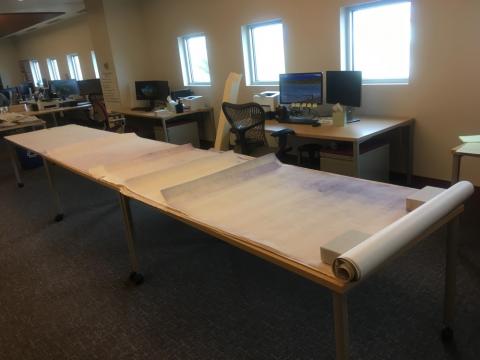
Image Source: Length of the drawings, Edward C. Light Schematic Drawings of the Hughes H-4 Hercules "Spruce Goose" Seaplane, 1941-1950. MS-00920. Special Collections and Archives, University Libraries, University of Nevada, Las Vegas. Las Vegas, Nevada.
Included in the engineering design drawings in this collection, in addition to schematic design drawings, are a number of perspective drawings providing a deeper look into the Spruce Goose’s assembly. Due to the Spruce Goose’s enormous size, Hughes and his engineers developed an innovative hydraulic system to move the plane’s control surfaces, as detailed in the drawings. These drawings predate computer-aided drafting (CAD) software by over a decade, demonstrating the engineering team’s skill in producing drawings for fabrication, assembly, and flight.
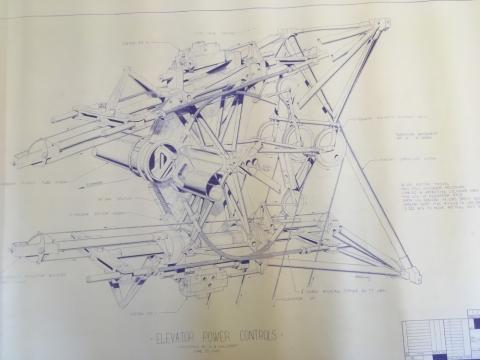
Image Source: Elevator power controls diagram, Edward C. Light Schematic Drawings of the Hughes H-4 Hercules "Spruce Goose" Seaplane, 1941-1950. MS-00920. Special Collections and Archives, University Libraries, University of Nevada, Las Vegas. Las Vegas, Nevada.
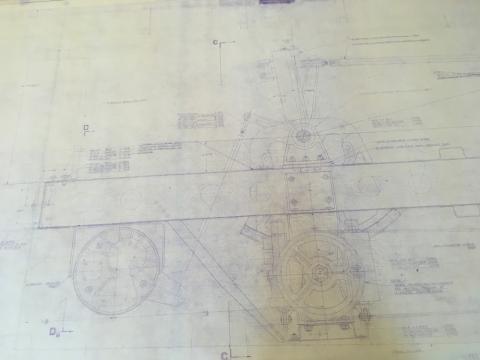
Image Source: Hull cabin flight control over-systems, Edward C. Light Schematic Drawings of the Hughes H-4 Hercules "Spruce Goose" Seaplane, 1941-1950. MS-00920. Special Collections and Archives, University Libraries, University of Nevada, Las Vegas. Las Vegas, Nevada.
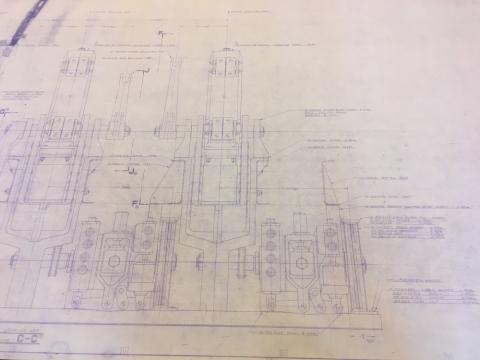
Image Source: Hull cabin flight control over-systems, Edward C. Light Schematic Drawings of the Hughes H-4 Hercules "Spruce Goose" Seaplane, 1941-1950. MS-00920. Special Collections and Archives, University Libraries, University of Nevada, Las Vegas. Las Vegas, Nevada.
The Edward C. Light Schematic Drawings of the Hughes H-4 Hercules "Spruce Goose" Seaplane, as well as a number of Howard Hughes collections, including his aeronautical photographs, are all available for viewing at UNLV Libraries Special Collections and Archives, so come down to check them out!
Sources:
Bain, Charles R. G. High Hulls: Flying Boats of the 1930s and 1940s. Fonthill Media. 2018.
History.com Editors. “Spruce Goose lies.” HISTORY. November 29, 2009. Accessed July 1, 2019. https://www.history.com/this-day-in-history/spruce-goose-flies
“The Spruce Goose.” Evergreen Aviation & Space Museum. 2018. Accessed July 1, 2019. https://www.evergreenmuseum.org/the-spruce-goose


